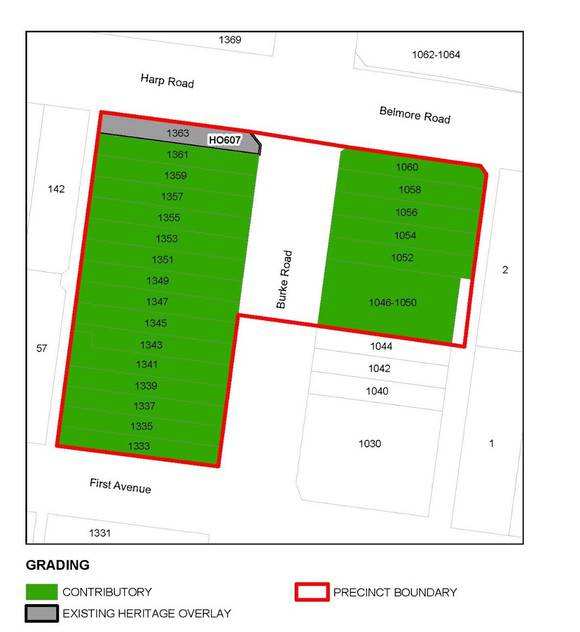| Back to search results » | Back to search page » |
|
Burke Road Commercial Precinct
LocationBurke Road KEW and Burke Road BALWYN, BOROONDARA CITY LevelIncl in HO area contributory |
|
Statement of Significance
What is Significant?
The Burke Road Commercial Precinct, at 1333-1363 Burke Road, Kew and
1046-1060 Burke Road, Balwyn, is significant. The first cluster of six
shops in the Spanish Mission architectural style were built in
1931-33. The two rows of eight shops on either side of Burke Road were
built to similar Art Deco designs in the immediate postwar period, in
c.1948-50. The corner shop at no. 1363 was the last to be built in 1954. The 1954 shop designed by architect John Tovey is individually
Significant, and this is recognised in the HO (HO607). The remaining
shops are Contributory. Significant features of the Contributory shops include: the intact
and partially intact upper storey facades of the three two-storey
groupings of shops; the intact (or partial) early and original
shopfronts at 1333, 1337, 1351, 1052 and 1054 Burke Road, the form of
the shopfronts at 1345, 1349, 1353, and 1359 Burke Road, and the side
(First Avenue) elevation of 1333 Burke Road.
How is it significant?
The Burke Road Commercial Precinct is of local historical,
architectural, and aesthetic significance to the City of Boroondara.
Why is it significant?
The shopping precinct at 1333-1363 Burke Road, Kew and 1046-1060
Burke Road, Balwyn, is of historical significance for demonstrating
the development of smaller shopping strips in response to the interwar
expansion of Kew. Smaller shopping strips like the retail strip on
both sides of Burke Road catered to the growing needs of the new
residents in the immediate vicinity, where walkability and, after
WWII, increasing car ownership were key aspects. (Criterion A) Architecturally, the shops in the Burke Road Commercial Precinct are
significant for their ability to demonstrate typical and cohesive
forms of interwar commercial/retail buildings, built to front and side
boundaries, forming a continuous street wall, with roofs hidden behind
parapets. The cohesive character of this Precinct is enhanced by the
limited architectural styles of the shops, the three large groups of
shops, and the high degree of intactness of all their upper storey
facades. The high degree of visual and architectural cohesion of the
Burke Road Commercial Precinct distinguishes it from other comparable
commercial precincts in Kew, where the built form and overall
character is typically more mixed. (Criterion D and E) The interwar and early postwar-era shops demonstrate features
representative of predominantly only two architectural styles: the
interwar Spanish Mission style for the row of six shops at 1333-1343
Burke Road, and interwar Art Deco for the two rows of eight shops, at
1345-1359 and 1046-1060 Burke Road. The two corner shops at the
northern end at nos. 1363 and 1060 and the corner shop at no. 1333 at
the southern end are designed to address their corners and create
gateways into the Precinct. (Criterion D) The row of Spanish Mission shops at nos. 1333-1343 Burke Road, built
in 1931-33 is a relatively early example of a row of shops designed as
a cohesive group in the interwar Spanish Mission style. They are
comparable in terms of their Spanish Mission architectural style and
the integrity of the upper-storey with the fine and more elaborately
ornamented row of Spanish Mission shops at 104-114 Canterbury Road.
The Canterbury Road shops were commenced only slightly later, in
1932-33. Unlike the shops at Burke Road, the Canterbury Road shops
retain a high proportion of their original high quality shopfronts.
(Criterion D) Aesthetically, the single-storey corner shop and offices at 1363
Burke Road, designed by architect John Tovey in 1954, is significant,
and this is recognised by its listing as an individually significant
place in the HO (HO607). (Criterion E) For a full list of the individual gradings within the precinct,
please refer to the attached PDF citation, or the child records.
Group
Commercial
Category
Commercial Precinct






